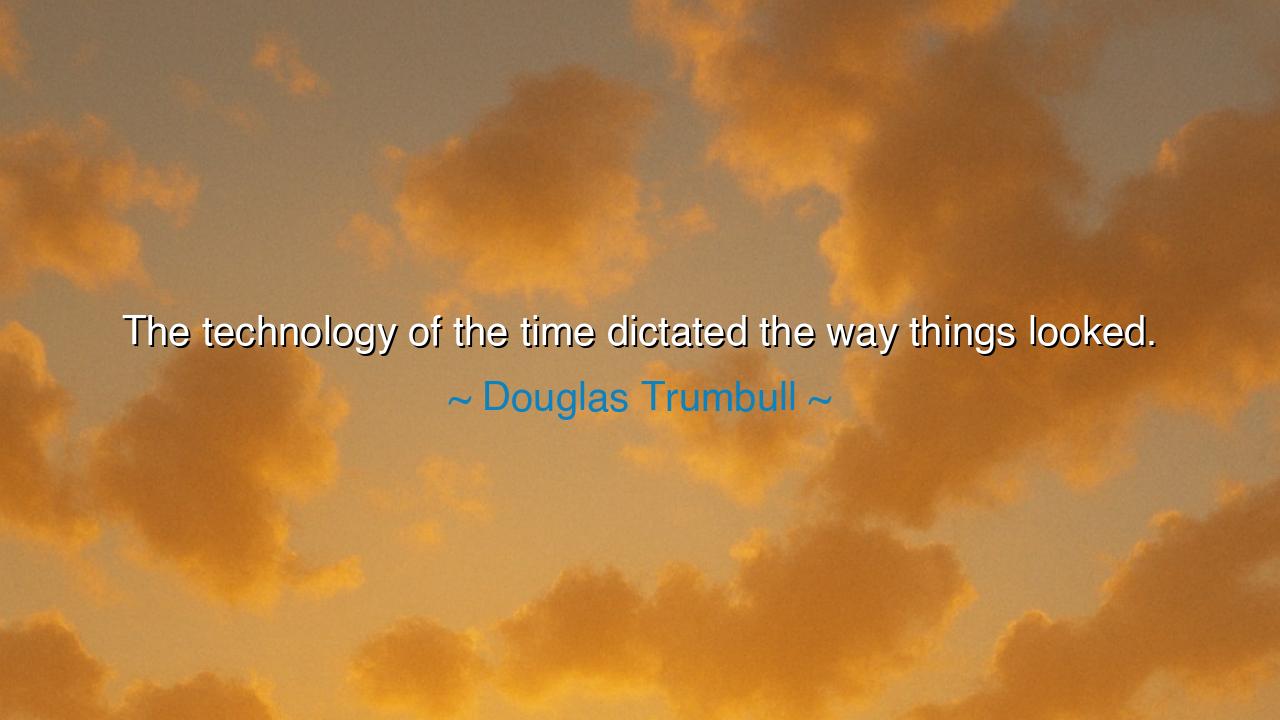
The technology of the time dictated the way things looked.






The words of Douglas Trumbull, “The technology of the time dictated the way things looked,” resound as a profound observation on the intimate relationship between technology and artistic expression. He reminds us that the forms, styles, and appearances of our creations are often shaped not only by imagination but by the tools available to realize it. In Trumbull’s insight lies the recognition that progress in technique—mechanical, chemical, or digital—directly informs the aesthetic of an era, coloring the visions of creators and shaping the perceptions of audiences.
The origin of this reflection lies in Trumbull’s life as a visionary filmmaker and special effects pioneer, known for his work on 2001: A Space Odyssey and Blade Runner. In these monumental projects, he faced the limitations of the era’s visual effects technology. The visual language of these films—the movement of spacecraft, the depiction of alien environments, the realism of space itself—was a direct product of what the technology of the 1960s and 1980s could accomplish. His words acknowledge that tools constrain and inspire simultaneously, shaping the final work as much as creative vision itself.
History offers clear illustration of this principle. During the Renaissance, the development of linear perspective and oil paints revolutionized visual art. Artists like Leonardo da Vinci and Raphael could depict depth, light, and texture in ways previously unimaginable. Yet it was the technology of pigments, brushes, and perspective techniques that dictated the form of their expression. Just as Trumbull observed in film, technology provides both the limits and the palette from which innovation emerges.
Even in the world of cinema, early examples abound. The invention of Technicolor in the 1930s allowed filmmakers to explore new realms of visual storytelling. Without such technology, iconic films like The Wizard of Oz could not convey their lush, vibrant landscapes. The technology dictated the aesthetic possibilities, and artists worked within these constraints to create experiences that continue to inspire. Trumbull’s insight is timeless: every medium reflects both the limitations and possibilities of its era.
The meaning of his words extends beyond film and art. Technology shapes architecture, engineering, and even everyday objects. Gothic cathedrals rose because stone-cutting techniques and scaffolding technology allowed it; skyscrapers soared only when steel frames and elevators were perfected. Trumbull’s observation teaches that innovation in tools is inseparable from innovation in form, and that understanding this relationship is essential for creators seeking to leave a lasting mark.
The lesson for future generations is clear: mastery of the tools of one’s time is inseparable from mastery of expression. To create meaningfully, one must understand both what is possible and what is constrained by current technology. Trumbull’s words urge humility and curiosity: respect the influence of your instruments, learn to exploit their strengths, and recognize their limitations as part of the creative process.
Practical action flows naturally. Study the technologies available in your field, whether physical tools, digital platforms, or conceptual frameworks. Experiment within their constraints, pushing the boundaries of what they allow. Document innovations and techniques, so that future creators may build upon them, understanding both the achievements and limitations of your era.
Thus, let Douglas Trumbull’s words endure as wisdom for all makers: the technology of the time dictates the way things look. By understanding, mastering, and innovating within these parameters, we honor both the past and the future of creation. Every masterpiece, every invention, every design carries the imprint of its era, reminding us that the marriage of imagination and technology is eternal, and that artistry always walks hand in hand with the tools that make it possible.






AAdministratorAdministrator
Welcome, honored guests. Please leave a comment, we will respond soon